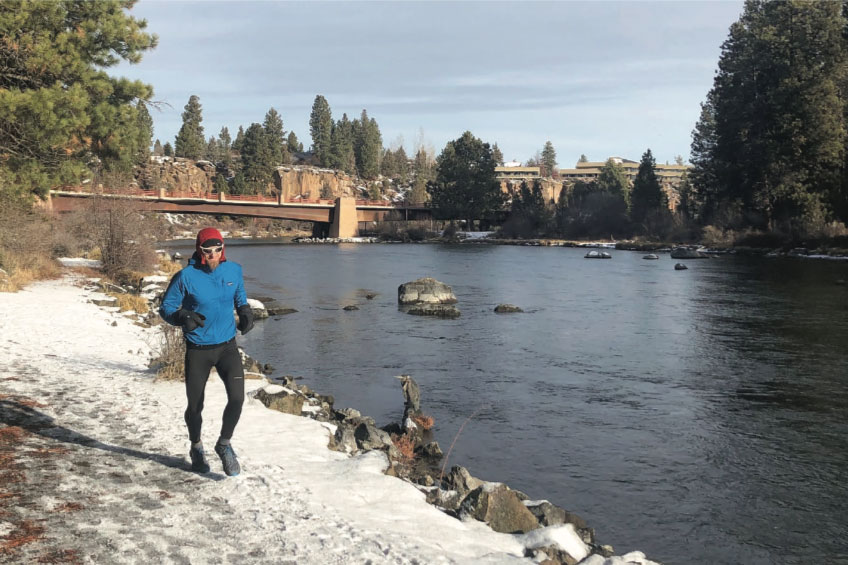Running Safely With Old Man Winter

The temperature is below freezing and it’s still dark outside. The alarm goes off and you hit snooze, pulling those warm covers ever higher. Still, your training plan calls for a run.
Winter running can be challenging. Cold temperatures, slick footing, and being forced off the quiet of the trails to the road are just a few of the obstacles we all face when training through the winter months. The good news is that there’s joy to be found even on the coldest days. It’s all a matter of perspective, the right gear, and some winter safety precautions.
Running on the Roads
Since many trails are under snow in the winter, you’ll most likely be confined to running roads. I use these times as an opportunity to explore a combination of different loops and circuits in surrounding neighborhoods where traffic is generally confined to local residents. I like to avoid the main roads where traffic is heavier. Although the snow isn’t cleared quite as quickly in the quiet neighborhoods, local traffic tends to pack the snow down enough to make it runnable with traction. If you do find yourself on a busier street, always run against traffic. That way you’ll be able to see what’s coming your way, and assess if individual drivers are paying attention to you.
Other Places to Explore
If you’re fortunate enough to live near a university, run a circuit on campus. Universities have their own maintenance crews and don’t rely on local city maintenance to clear roads and sidewalks after snowstorms. Since universities are pedestrian-friendly, the campus crews are quick to clear walkways and paths for students and faculty. Cemeteries are another locale to check out in the winter for a potential run circuit.
Wear Bright Clothing
Visibility is paramount when running in winter. Since you end up running on roads more, drivers need to be able to see you. Remember that drivers are facing their own set of complications behind the wheel. Icy windows and slick conditions don’t leave room for additional challenges; don’t be one. If you are running before dawn or after dusk, invest in a good headlamp with a red blinking rear light for safety. Reflective vests are a good idea if you find your routes include a fair number of busy streets.
Layer It Up
Layering is everything when it comes to winter running comfort. Above the waist, start with a base layer long sleeve and add an insulation layer over the base layer. Then, don a windproof layer depending on temperature. Mild days may only call for a vest (i.e., wind protection for your torso only). However, a windy, cold day will require a full windproof jacket. Wear a beanie that covers your ears and a buff around your neck on cold days. The buff can double as a facemask on those extra cold excursions. On your lower half a lightly insulated tight is my favorite. Hand protection is a must. I hate cold hands and opt for a mitten instead of gloves. On a particularly cold outing, especially long run days, I use hand warmer packets inside my mittens. Lastly, use eye protection. Wearing glasses in the winter can help protect your corneas from freezing (rare, but a possibility). It’s also helpful to avoid the glare of the sun reflecting off snow on a clear day.
Tip: Wear your glasses on the outside of the beanie to keep your ears warmer and cut down on fogging.
Shoes and Traction
I prefer trail running shoes with good tread for my winter outings, even if I’m running on roads. If you live in a location where temperatures stay below freezing, then snow conditions may not require more than decent tread. However, if you get freeze/thaw cycles, traction is essential. There are removable traction devices like YakTraxs (yaktrax.com) and Kahtoola MICROspikes (kahtoola.com). You can also easily stud your shoes with a power drill and some sheet metal screws from your local hardware store (Check out my site for a how-to post: GoBroncoBilly.com/Studs).
I currently opt for waterproof shoes with small micro-gators to keep the snow out when running though deeper snow sections. However, for years I simply bought my non-waterproof trail shoes a half size bigger, studded them, and wore a wicking layer sock in tandem with a wool sock over it to keep my feet warm. It doesn’t have to be fancy.
The key to winter running really is preparation. If approached using the aforementioned tips, the cold months can be a winter wonderland full of memorable adventure. Just remember to slow down, be safe, and enjoy the season.
Giddyup!